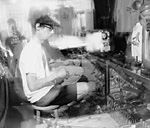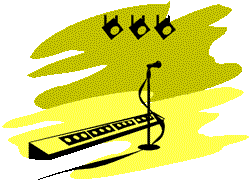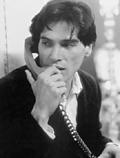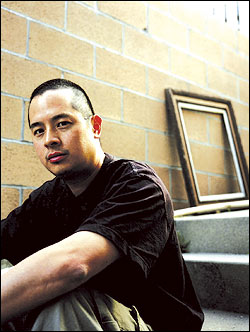SATURDAY, OCTOBER 23. 1:50PM. Five television sets hooked up to Atari 2600 machines with their sound turned down sit along the counter of Capitol Hill’s Hi-Score Arcade. Standing behind one of them, screwdriver in hand, is Jake Stratten, who looks like a mischievous, oversized kid in his faded yellow Pac-Man T-shirt and horn-rims. Stratten is trying to fix the screen of his ancient television set—right now, the picture is squeezed into the middle third of the screen. “It’s my TV,” he explains. “It’s a hand-me-down from an old roommate. I never know how long the picture’s gonna last.”
“Should I go beg the pawnshop for another TV?” asks cohort Zach Orgel. The two, along with Beth Fell, own the Hi-Score.
“Not yet,” Stratten says. He figures there may be some life left in the old beast.
That philosophy has served Stratten, Fell, and Orgel well in the five years since the three, all 29 or 30 years old, opened a sort of “anything boutique” called Penny and Perk. Soon the shop focused on old toys, particularly of ’70s and ’80s vintage. The store was a modest hit, and they expanded by opening the arcade, which is heavy on old-school video and pinball games. And in 1996, they began holding annual Atari 2600 Championships—a tribute to the first great video games, mainstays of the mid-1980s. Though nowhere near huge—the store’s owners report that at best they break even financially on the contest—it does attract a loyal base of old-school, nostalgic participants and onlookers, many of whom are serious Atari aficionados.
Older isn’t always better, however: After some more tinkering, Stratten gives up on his set, and Brent Carpenter, a friend who lives nearby, volunteers his. A 26-year-old drummer (he’s in a “goofy punk rock and roll band” called Blue Collar) and an artist who’s designed commemorative T-shirts for the contest since 1997, Carpenter is a gangly, affable guy who rediscovered the joys of Atari a few years ago. “I never got very interested in newer games,” he says. “Even though the earlier games are pretty silly, they’ve got kind of a cooler quality.”
“Atari is an equalizer,” adds Gaje Wagner, 31, last year’s champion. “With modern games, you can learn strategies that let you play forever if you’re really good. But with Atari, it’s really basic. It’s like playing checkers as opposed to chess.” The best example of this let-the-cards-fall-where-they-may rule may be that Wagner, who hasn’t hooked up his Atari in two years, won the ’98 championship while nursing a hangover from his 10-year high school reunion the night before. “I had to drink a lot of water that day,” he recalls.
3PM. As Brian Rauschenbach, the DJ who’s spinning old-school hip-hop and electro for the event, drops Audio 2’s “Top Billin’,” Stratten announces over the small Hi-Score PA that the competition begins in 15 minutes. Just as he finishes, five large pizzas—cheese and pepperoni—from nearby Hot Mama’s pizzeria arrive. The arcade’s front area is crowded with disheveled indie-rockers wearing band T-shirts, Converse sneakers, and Buddy Holly glasses; I check the back room for spillover, but only a lone older black man plays Xevious in the back corner.
Twenty-six people enter the contest, and the first game they play is Missile Command. Four screens (another has fritzed out since Carpenter replaced Stratten’s) show four versions of the same almost childishly simple design, and—as old TVs will—in four almost completely different color schemes. Missile Command is simple: On a battlefield, a series of napalm bombs (represented by lines that zigzag when diagonally directed) descend, and your job is to blow up their tail ends so they don’t blast apart the main shooter in the middle or the six backups flanking it.
The rules of Missile Command and the other games the competitors will play today are dead simple; they can make modern PlayStation-accustomed gamers grimace with condescension. But they are anything but easy. For one, the 2600 games are incredibly primitive conceptually and graphically, which means technologically as well: For Missile Command, you have to anticipate where to shoot a couple beats in advance, since it’ll take that long for the shot to arrive—by which time the lines may already have gone past. All of this happens in real enough time and builds up decent enough speed. But mostly, the tedium might drive a Final Fantasy player, accustomed to turbo-charged action, out of his mind.
This is doubly true regarding the paddles, which resemble stereo volume control dials: According to Beth Fell, “It’s hard to find paddles that work anymore”—and, in fact, during the third round, Warlord, several break down. In the interest of making the 2600 Championships encompass “the full gamut of Atari skills,” as Orgel puts it, the contest’s organizers have divided the competition into joystick and paddle games. So when Missile Command is over, the next round finds the contestants playing Kaboom!, in which a broadly appointed cartoon pirate drops bombs that you try to catch with a paddle in the lower screen. It’s not a very high-scoring game: The low thousands are about as good as it gets, as opposed to the 60,000-70,000 range earned by Missile Command’s top scorers, and it takes less than 20 minutes (as opposed to the better part of an hour spent on Missile Command) for all 26 contestants to finish playing Kaboom!.
5PM. After the top 12 scorers have moved on to Warlord (defend four corners of video bricks against a ball that depletes their supply, ࠬa Breakout; with paddle breakdown this takes about 40 minutes for six sets of head-to-head competitors to complete) and then the six winners to Airsea Battle (shoot airplanes or flying critters overhead or, alternately, boats and assorted sea life from above; total time of all paired games, five minutes), three contestants are left to play the final “secret” game.
“In the past,” Jake announces to the 20-odd strong crowd, “we’ve had more obscure games than this, but not many harder. Today’s final game is . . . Moon Patrol!” Indeed, Moon Patrol’s what-the-hell-were-they-thinking playability (you, a crawling buggy, can shoot only a certain distance above and in front while being swarmed upon from both directions, plus you die if you don’t jump—about a quarter-inch—over the rocks that stand in your way) make it a perfect tournament-ender: It ends quickly, summing up both the tongue-in-cheek nostalgia and the harder-than-it-looks gamesmanship the Championship celebrates.
First up is Jake Conroy, a lanky Capitol Hill resident who lasts less than a minute and scores only 1400 points. His consolation prize is an old brown box that holds five 2600 cartridges. Next is Darren Hembd, who fares better: Playing carefully, he stretches his time onscreen to a full four minutes, scoring 2500 points before being offed by a rogue rock.
The final contestant is Greg Alt, a game freak from Salt Lake City who owns some 250 Atari 2600 games; he’s lived in Seattle for three years and programs games for Surreal Softwear, near Seattle Center. Alt, who wears his brown hair long and sports a full beard, concentrates hard, shooting everything in sight, and though his game only lasts half the time of Hembd’s, he racks up 700 more points. Hembd takes home a Pac-Man decorated popcorn tin; Alt, as the grand prize-winner, receives a silver Atari jacket that wouldn’t fit a kindergartner, much less a 28-year-old.
Most of the earlier crowd has either gone home or begun popping quarters into the Cactus Canyon pinball machine or the Rush the Rock video game. But the day has been successful: About 50 people altogether have shown up for the contest, and many buy commemorative T-shirts before heading out. And most of the participants have agreed to return next year, for the fifth annual tourney. Which, with any luck, will give the Hi-Score’s owners time to find more working TVs and fabulous prizes.








